TIBET, THE CLIMATE EMERGENCY AND CHINA’S SECRET DIVIDEND
Blog one of two on climate change , glaciers, rivers and China’s ecological civilisation
#gabriellafitte
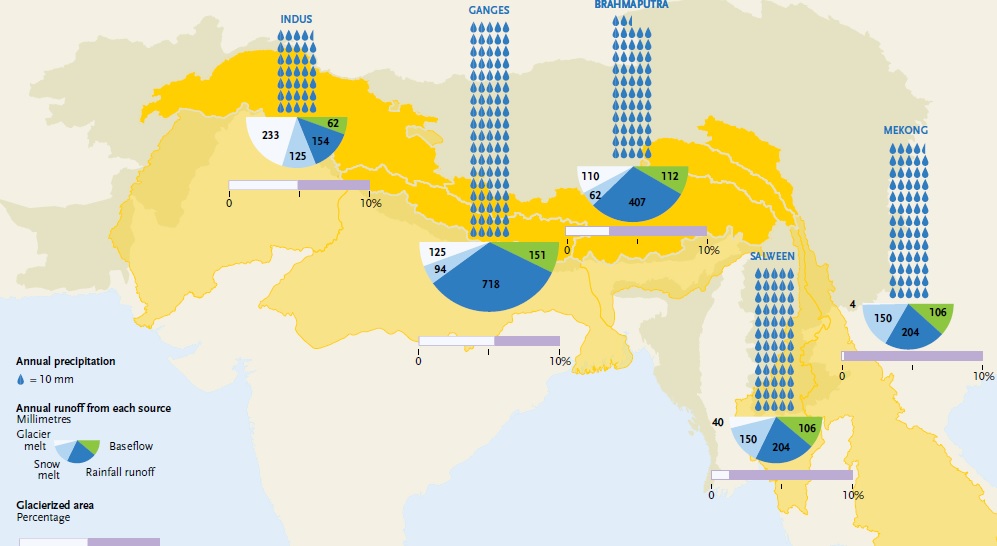
Source: ICIMOD Himalayan Climate Atlas 2015
When 11,000 scientists world wide issue a warning that collectively we face “untold suffering due to the climate crisis”, yet the world’s governments response is totally inadequate, we pay attention, for a moment. We move on. Someone really oughta do something.
The global climate emergency, long coming and now peaking, faces crunch time when all world governments gather in Madrid early December 2019. Starting 2 December, the Conference of the Parties (COP25) of the UN Framework Convention on Climate Change assembles. The popular swell of demands for urgent and effective action to reduce carbon emissions and hold climate warming to no more than a manageable 1.5 degrees, is set to climax.
The world will be watching , to see if governments are at last willing to do more than talk vaguely of “common but differentiated responsibilities” to act. Currently each country selects its own targets. That is as far as the world got in Paris in 2015. Since then, climate extremes have only gotten worse. What seemed a distant danger is now happening to us all: more intense droughts, floods, fires, cyclones, blizzards.
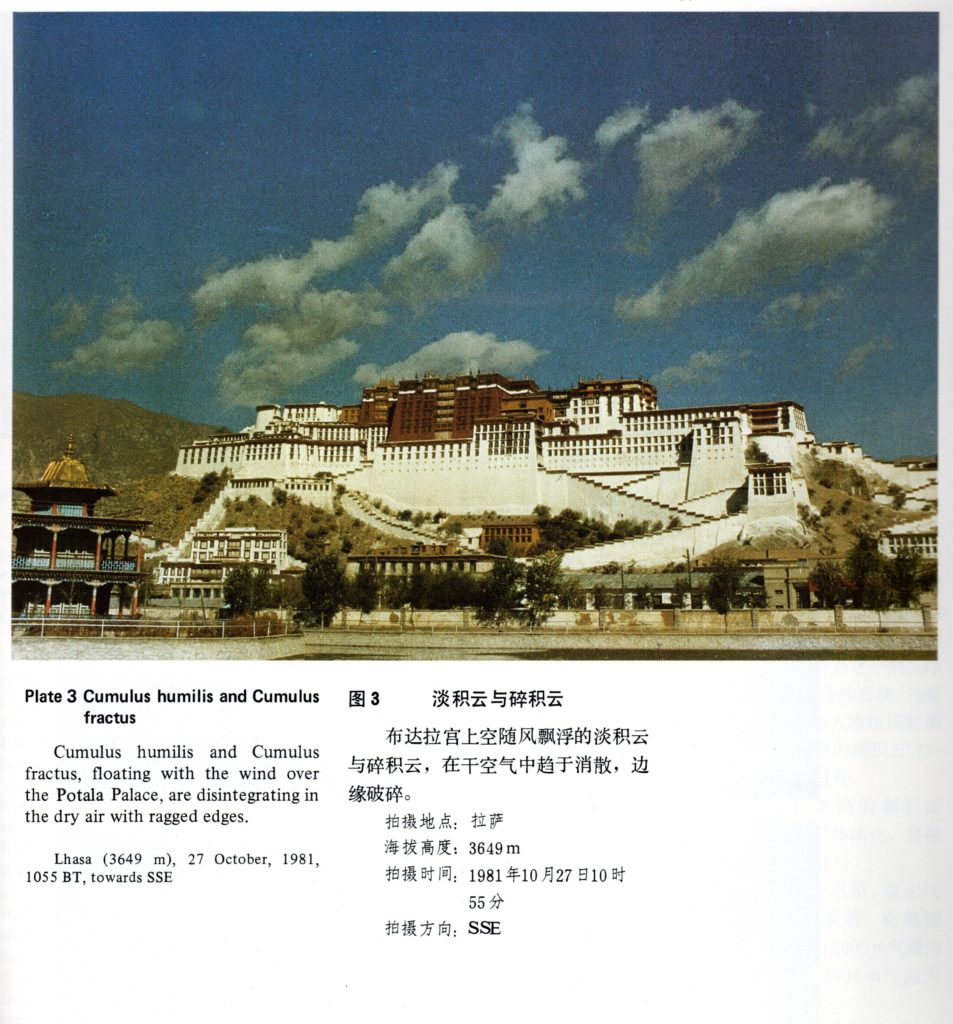
Source: Atlas of Clouds over the Qinghai-Xizang Plateau, 1986
Will COP25 Madrid 2019 change anything? As always, all the hopes, fears and attention will be on the biggest emitters, none bigger than China. The smaller countries, other than photogenic Pacific islands disappearing under rising waves, tend to be also-rans. The world’s emerging economies, global south, developing countries, whatever you call them, did almost nothing to cause the climate crisis, and get little attention, except for one country that positions itself as the leader and exemplary role model for all developing countries: China.
In a world where the US denies the reality of climate change, and Europe is unable to agree on anything, it is understandable that the hopefuls pin their hopes on China. But that is hope against hope. All China ever agreed to in Paris in 2015 was to reduce the carbon intensity of its heavy industries. China did not agree to actually begin reducing its carbon emissions until 2030; yet 2030 is the date set by the Intergovernmental Panel on Climate Change (IPCC) for the world to complete its emissions reductions, if we are, as a planet, to have a real chance of stopping climate warming from running away uncontrollably.
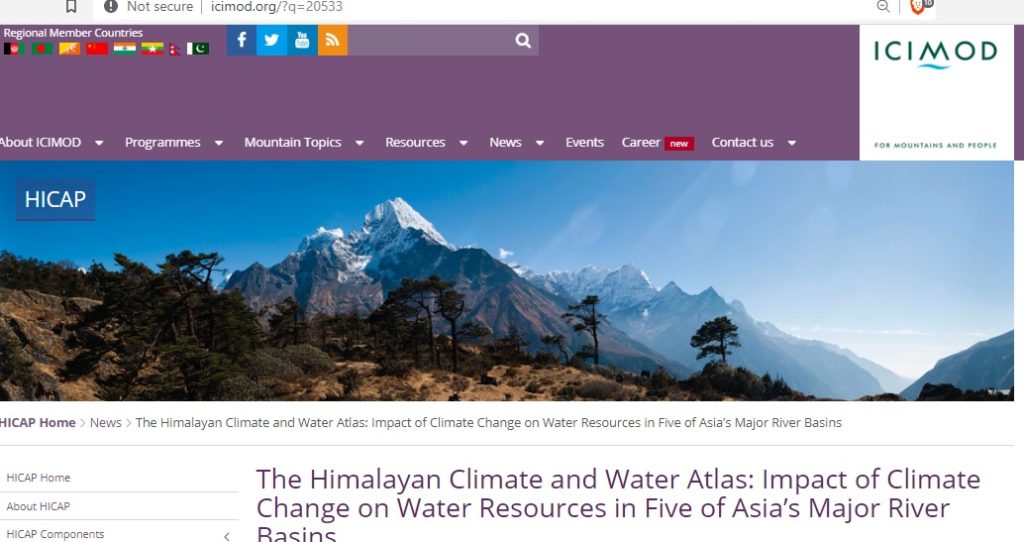
What of Tibet? By area, the Tibetan Plateau is almost two percent of the planet’s land surface, the same size as Western Europe. Tibet matters, not only because of its extent but its height, half way up into the troposphere, so high it diverts the jet stream around Tibet, not over it. Nowhere else on earth does that. In winter the jet stream, racing west round the mid latitudes, diverts around the south side of the plateau; in summer it switches to divert round the northern edges of Tibet.
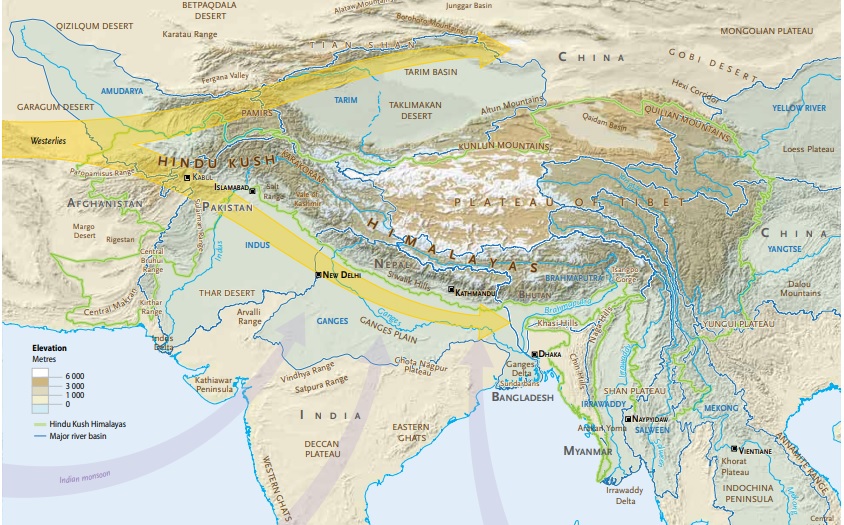
China is acutely aware that the Tibet is upriver, with both of China’s great rivers, the Yellow and the Yangtze, rising in the glaciers of Tibet. Tibet is also upwind of lowland China, and the climate in Tibet, capable of drawing monsoons deep inland, has a profound impact on the climate of Asia. It’s only in recent decades that climate scientists managed to connect the dots and discover how interdependent climates are, how teleconnections and forcings influence climates far away.
The intense cold of Tibet in winter is well known, less well known is how fast the entire Tibetan plateau heats in spring, especially on the bare rock of the mountain slopes, above the vegetation line. Intense sun, in the largely dry springtime climate, heats the thin air and bare rock of Tibet fast, which drives the monsoon dynamic, both the arrival in summer of the South Asian monsoon from the Indian Ocean and Bay of Bengal; then, a little later, the arrival of the East Asian monsoon from the tropical Pacific
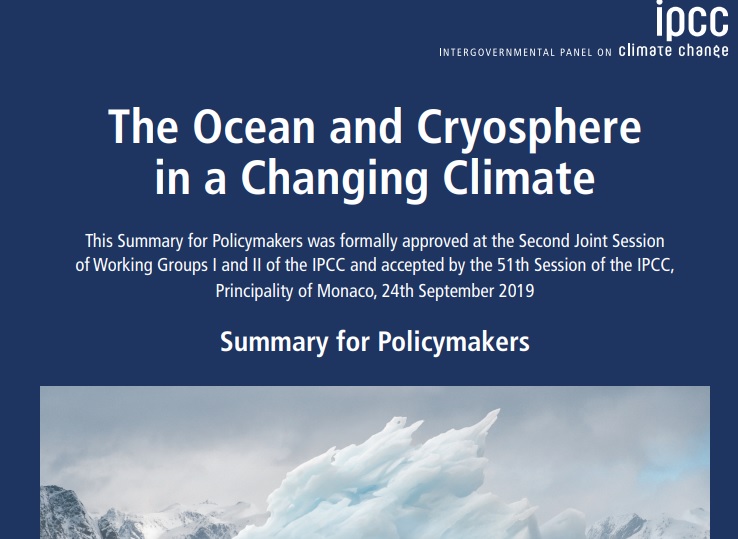
So Tibet does matter, not only to Tibetans. It matters especially to China and Japan, most immediately downwind, but weather and climate in Tibet have measurable effects in North America too.
However, the world knows little about climate change in Tibet, although the Tibetan exile government has tried for a decade or more to raise the profile. So this Rukor blog lays out the evidence on what is likely to happen in Tibet, over the coming decades, if the world succeeds in Madrid 2019 in effectively curbing emissions, and if the world yet again fails to take effective action to reduce emissions.
This blog draws on the extensive mapping and modelling done by climate scientists on the future climate of Tibet, not only the melting of the glaciers, but the whole range of climate changes under way, and accelerating. This blog features maps of the future climate of Tibet, in the 2040s, 2060s, even in 2095, both on the assumption that carbon emissions are globally reduced, and on the alternative assumption the world fails to take effective action.
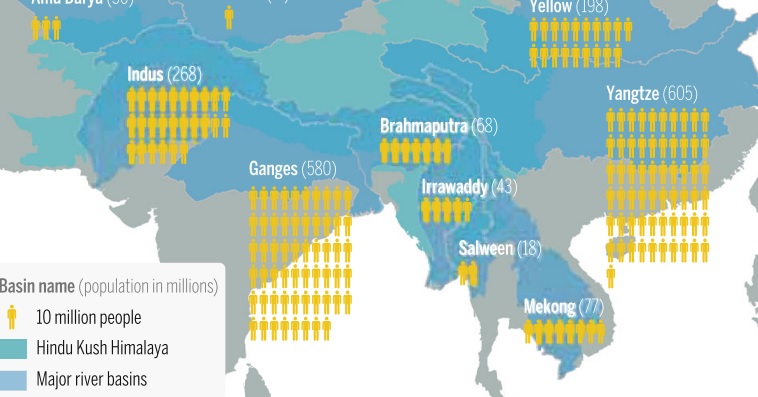
China congratulates itself on being the global leader in ecological civilisation construction, but the data on Tibet suggest otherwise.
IPCC TAKES US UP INTO THE CRYOSPHERE
From Brooklyn to Bangladesh the headlines arising from the latest IPCC report, on Oceans and Cryosphere, have focussed on the prospects of a dangerous rise in the levels of the seas lapping our shores.
Far from the shores, and the headlines, the IPCC also reported on the high mountains and glaciers at the start of the water cycle. It is there that climate change is impacting lives right now, in myriad ways.
In the Himalayas, Tibetan communities have skilfully managed precipitous, precarious environments for thousands of years, but now face ruin caused by climate change. The IPCC report on the cryosphere –the world’s cold regions- and the oceans details the remarkable adaptability of Tibetans, in the mountains and across the high Tibetan Plateau, as climate change changes everything. Adaptable as they are, those changes are accelerating, cancelling customary livelihoods.
It’s not only the headline writers in lowland cities who seldom notice the multiple impacts of climate change right now in the highlands, it is also the politicians, who now benefit from increasing river runoff as glaciers melt.
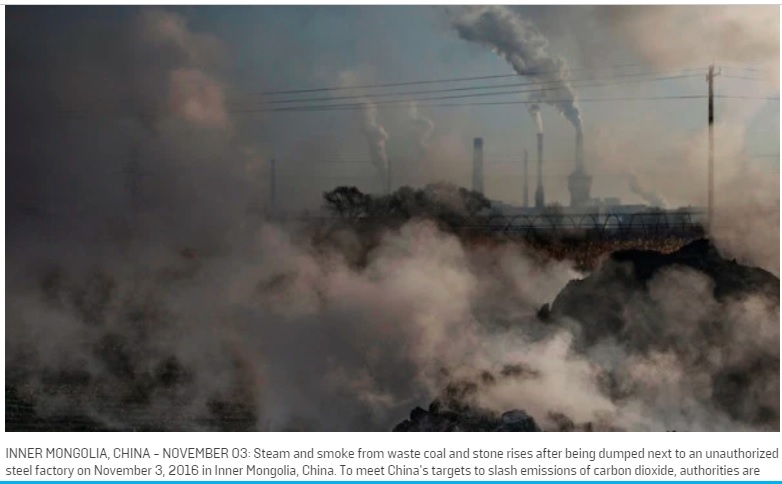
This is especially so in China, where the great Yellow River, cradle of China’s civilisation, runs dry, exhausted by draining off its waters for heavy industry, especially coal, coal chemicals and coal-fired power plant cooling towers, across northern China. http://paper.people.com.cn/zgnyb/html/2018-02/26/content_1839095.htm
CHINA’S SECRET DIVIDEND: RIVER RUNOFF ENHANCED BY GLACIER MELT
Rather than turn away from dependence on coal, or commit to specific emission reduction targets, China quietly enjoys a secret dividend, of increased flow, down the Yellow River from the glaciers of Tibet, as they melt at unprecedented rate.
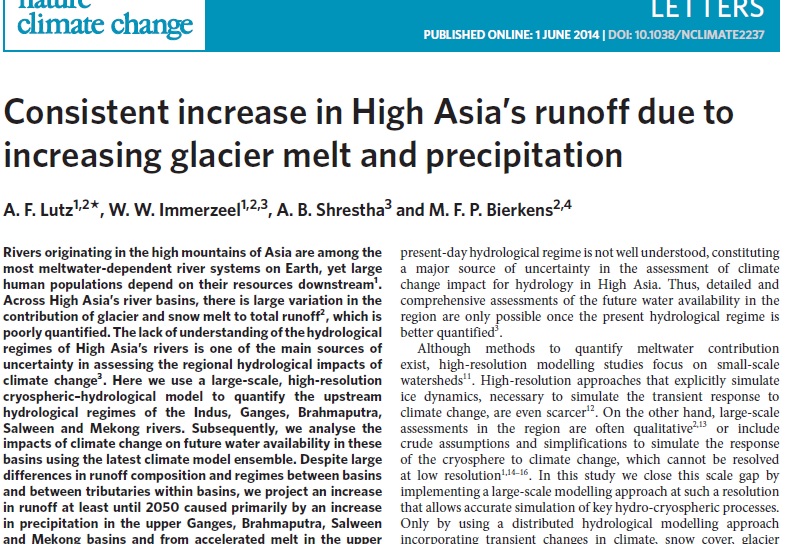
The glaciers at the head of the great rivers coming from Tibet –the Indus, Yangtze and Mekong as well as the Yellow- can dispense this special dividend only for a while, until they dwindle and disappear. Now the IPCC has put a timeline on this. Peak water will come as soon as mid-century; after that the shrinking glaciers will retreat upslope, unable to replenish, fading from view. By the end of this century they will largely be gone.
The IPCC, marshalling all available evidence, says: “Melt water from glaciers in the mountains can be an important source of water in hot and dry years or seasons when river runoff would otherwise be low, and thereby also reducing variability in total river runoff from year to year, even hundreds of kilometres away from the glaciers. As glaciers shrink, annual glacier runoff typically first increases, until a turning point, often called “peak water” is reached, upon which runoff declines.” IPCC SROCC 2-25, 2-28
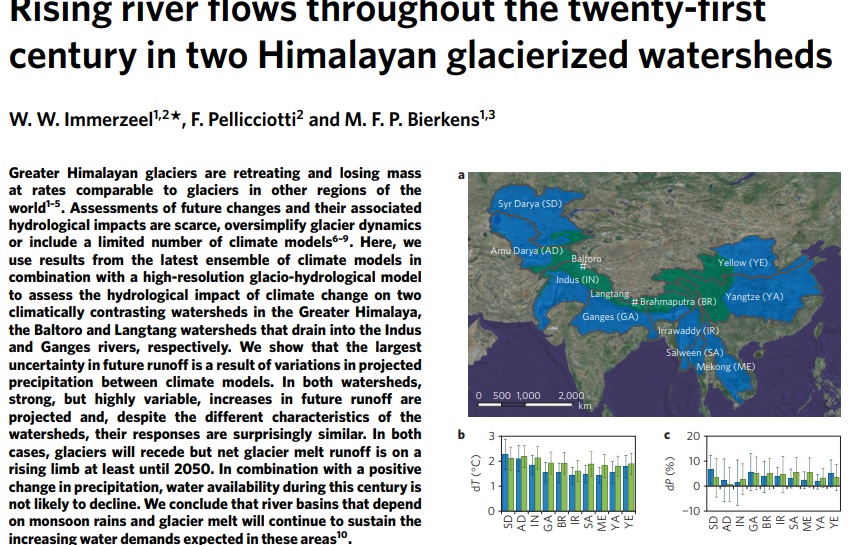
“The average winter runoff is expected to increase (high confidence), and spring peak maxima will occur earlier (very high confidence). Although observed and projected trends in annual runoff vary substantially among regions and can even be opposite in sign, there is high confidence that average annual runoff from glaciers will have reached a peak, with declining runoff thereafter, at the latest by the end of the 21st century in most regions. The projected changes in runoff are expected to affect downstream water management, related hazards and ecosystems.” IPCC SROCC 2-26
This Rukor report delves not only into the implications of the IPCC Cryosphere and Oceans report, but also brings you the scientific research IPCC relies on.
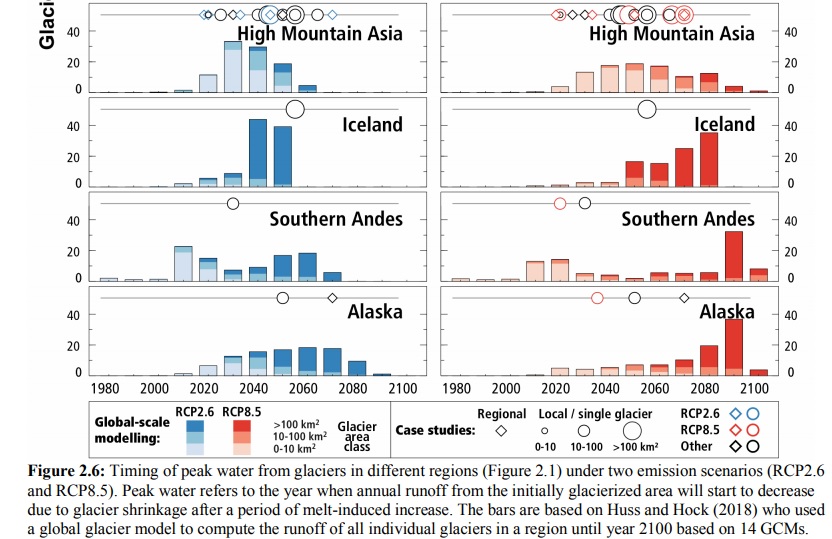
IPCC estimates of the glacier melt dividend downstream. In High Mountain Asia, which is mostly the Tibetan Plateau, the key question is when will increased runoff due to climate warming peak, and then dwindle as the glacial sources dwindle and disappear? The two graphs offer two differing answers, because they are based on two differing scenarios of future climate change emissions reductions. The graphs in blue assume the world will act quickly and effectively to reduce emissions; those in red assume governments fail to act and carbon emissions will continue rising. In both scenarios peak water will be mid-century, and then decline.
For the news cycle, and the attention span of political leaders, that’s way in the future. What matters now, and for decades to come, is increased runoff, a free public good delivered cost free for as long as it still snows in the Kunlun, Tian Shan, Tanglha, Amnye Machen , Hengduan and Himalayas: the mountains surrounding Tibet.
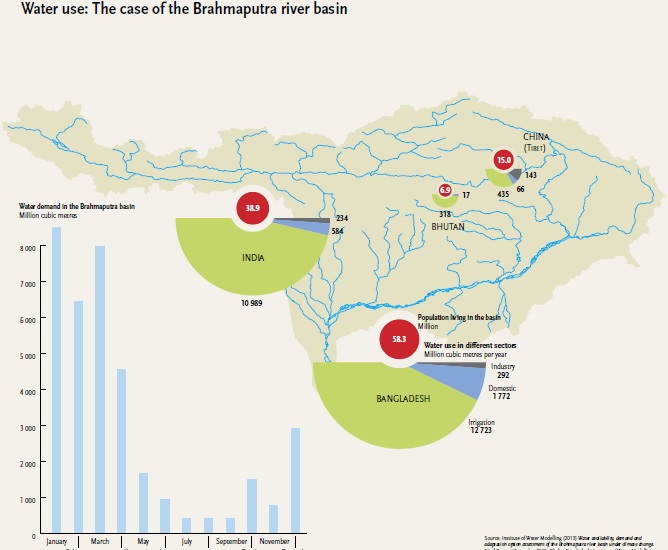
Only some of those mountain ranges capture monsoonal moisture and hold it as snow and ice, gradually releasing their melt into streams and rivers flowing across China. The Indus River benefits more from snow and ice melt, more on that below. Of China’s great rivers, the Yangtze and Yellow, both originating in Tibetan glaciers, the Yangtze is by far the bigger, its runoff augmented not only by glaciers at the source but also in Kham, well down the Dri Chu/Yangtze/Chang Jiang. The snowpeaks of Kham, such as the pilgrimage mountain Khawa Karpo (Meili Snow Mountain in Chinese) capture, store and release a lot of water.
For lowland China, the only river in need of a climate induced dividend of extra runoff is the Yellow. The dividend on the Yellow may be much less than on the Yangtze, where it only prolongs the flood season. On the Yellow River (Huang He in Chinese) the dividend may be quite modest, and not deliver extra water far below Tibet. The Yellow is one of the longest rivers in the world, much of it through desert.
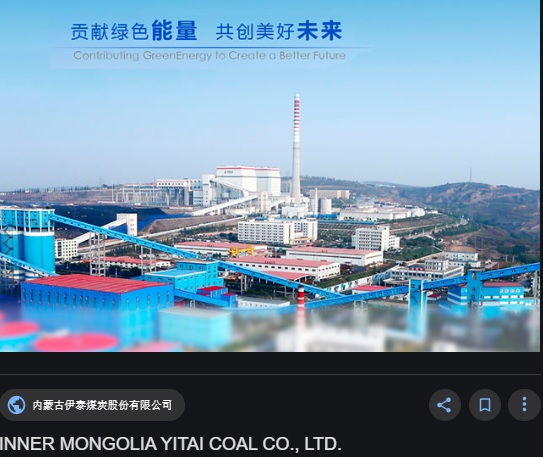
In recent decades, there have been serious proposals to greatly boost the Yellow River’s flow by diverting water away from Yangtze tributaries in Tibet, building dams to impound water, canals and tunnels to get that water across to the Yellow River which, in some Tibetan areas, is only 100 kms away, with mountains in between. This is the sort of challenge China’s engineers can overcome, at great cost to both budgets and nature.
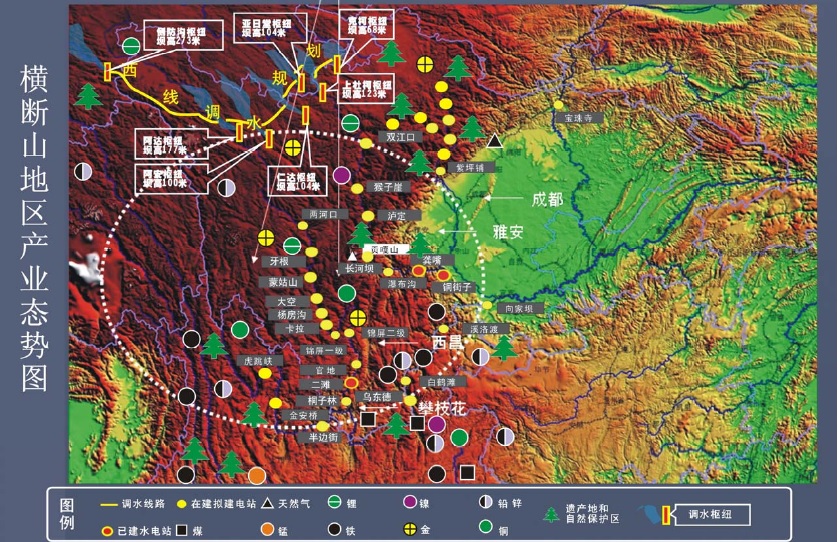
Officially, this huge project is the third stage of the three-stage South-to-North Water Transfer Project, and the first two stages, in lowland eastern China, are complete and operational. The third stage, still on the books of successive Five-Year Plans, is officially the Western Route, and has been thoroughly mapped. Yet there are no indications that it will actually be built. There may be many reasons why it languishes. The other two canals have been somewhat disappointing in delivering sufficient water northwards to be worth the cost. Damming and diverting water across Kham Kandze prefecture, a troubled area, would be expensive and difficult. But the bottom line is that even if done, it would not deliver enough water to the Yellow River to lift its river flow as far as the lower reaches, closest to Beijing, where extra water is most badly needed.
Diverting the Yangtze to the Yellow River, if it works as planned, would deliver its’ dividend to the heavily polluting industries of Qinghai Xining and Gansu Lanzhou, traversing Ningxia and then looping lengthily through arid Inner Mongolia, the core of China’s coal mining belt. There would be no increased flow beyond that, in Henan or Shandong.
No doubt the oil refineries and salt lake metals producers of Xining and Lanzhou would appreciate the availability of more water, likewise the steel mills and mass array of coal-fired power stations in Inner Mongolia. But they are not the centre of Chinese power, and may be on the brink of a similar de-industrialisation to China’s rust belt North-east. Older, more polluting heavy industries face new difficulties, not only from enforcement of pollution laws, but from China shifting the world’s factory abroad and further inland to coal-rich, oil-rich Xinjiang.
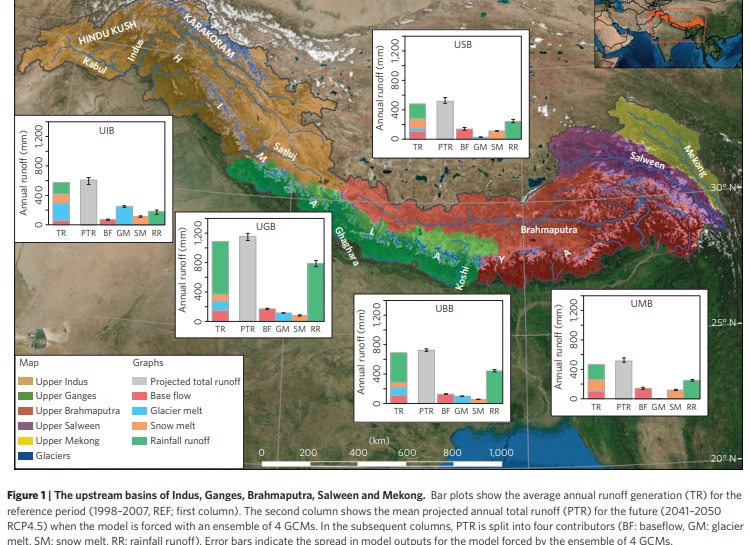
If these water-intensive and resource-intensive industries cannot succeed in persuading Beijing to further dam Kham Kandze, it is because the dividend of extra water would fail to get far enough downstream. Likewise, the dividend of extra runoff into the Yellow River from shrinking glaciers may not suffice to impact far downstream. No-one has sufficient evidence to be sure. The 14th Five-Year Plan for 2021 to 2025 is currently being actively debated among China’s policy elites; we may soon see whether the Western Route of the South-to-North Water Transfer Project still exists.
A NEW ERA OF CLIMATE RISK
IPCC tells us that even if carbon emissions are dramatically and rapidly cut and succeed in limiting global warming to 1.5C, 36% of the glaciers along the Hindu Kush and Himalayan range will have gone by 2100. If emissions are not cut, the loss increases to two-thirds.
The scientists watch as climate change sweeps aside all past calculations of risk and reward in the high mountains of Asia that ring Tibet. The IPCC report is recognised as authoritative because it draws together all that is known, all that has been measured and extrapolated to let us know what we, as a planet, are in for.

IPCC says: “At first, glacier runoff increases because the glacier melts faster and more water flows downhill from the glacier. However, there will be a turning point after several years or decades, often called ‘peak water’, after which glacier runoff and hence its contribution to river flow downstream will decline. Peak water runoff from glaciers can exceed the amount of initial yearly runoff by 50 percent or more. This excess water can be used in different ways, such as for hydropower or irrigation.” 2-28
IPCC reminds us we have all tended to regard water coming to us from upriver as a common pool resource, taken for granted, uncosted, a free public good to be exploited at will, without consequences. Economists call this an externality, which means provision of water doesn’t show up in the accounts. Now, in the era of climate change, nothing we took for granted can any longer be taken for granted. Common pool resources do have finite limits, which need to be respected, and governed for the welfare of all, for ecosystem health.
IPCC’s Summary, running to 1070 pages, is far from the only source we can turn to. The Kathmadu-based International Centre on Mountain Development (ICIMOD) also published, in 2019, a massive summation of all that is known about the Tibetan mountains and their glaciers.
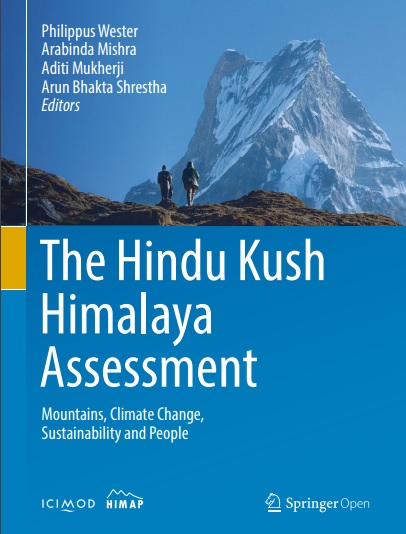
The 2019 ICIMOD Hindukush Himalaya Assessment: Mountains, Climate Change, Sustainability and People, only 627 pages, also identifies the payoff downstream of icemelt high in the mountains: “Recent work shows that within each basin there is significant variability; the closer one gets to the glaciers and snow reserves within a basin, the greater the relative importance of glacier and snowmelt runoff. Several large-scale benchmark studies have focused on quantifying the importance of glacier and snowmelt runoffs in the overall hydrology of large Asian river basins. Glaciers have the potential to provide seasonally delayed meltwater to the rivers. Meltwater can make the greatest contribution to river flow during warm and dry seasons, which is particularly important to the water budget in water-scarce lowlands that are densely populated. A global study estimating seasonally delayed glacier runoff relative to precipitation input showed that the Indus basin had the greatest human dependence on glacier water within the HinduKush Himalaya.” (p.262)
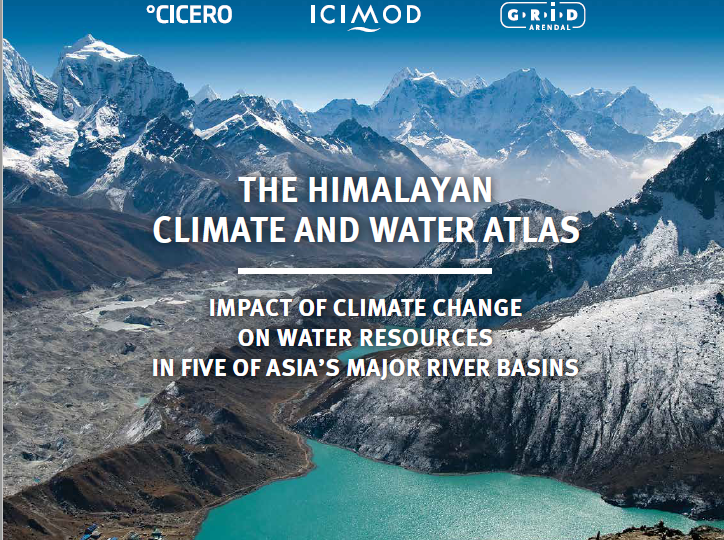
In 2015 ICIMOD published a detailed study of climate change and its likely effects, between 2021 and 2050 on the six major rivers originating in southern Tibet: the Indus, Ganges, Yarlung Tsangpo/Brahmaputra, Gyalmo Ngulchu/Salween and Zachu/Mekong. ICIMOD’s HIMALAYAN CLIMATE AND WATER ATLAS: IMPACT OF CLIMATE CHANGE ON WATER RESOURCES IN FIVE OF ASIA’S MAJOR RIVER BASINS, after reviewing the historic record of rainfall and temperature for each river, and after running computer projections for the year 2050, on a scenario of the world acting to curb emissions (RCP 4.5), and another scenario in which the world fails to do anything effective about emissions (RCP 8.5), came to the conclusion:
“Under both RCP scenarios, the amount of glacier and snow meltwater will decrease, while the amount of rainfall-runoff will increase, for the upper basins of the Brahmaputra, Ganges, Salween and Mekong. For the upper Indus basin, the contribution of glacial melt is projected to increase in both scenarios, and the contribution of snow melt and rainfall to runoff are projected to decrease for the extreme cases in the RCP 8.5 scenario. Overall, no significant decrease in runoff is projected until at least 2050 for all of the basins.
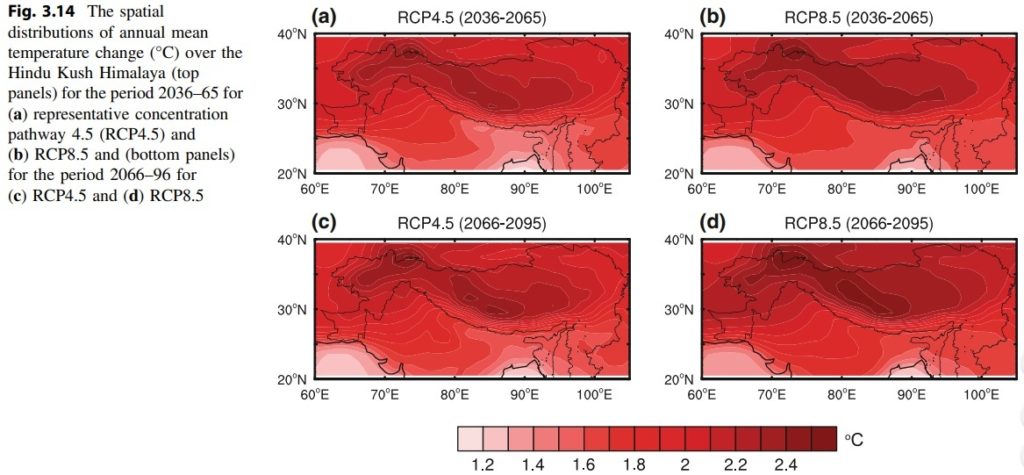
“An increase in runoff is projected for both RCP 4.5 and RCP 8.5 scenarios for the upper Ganges (1–27%), Brahmaputra (0–13%) and Mekong (2–20%) basins. Increasing precipitation is the main driver of this change, which will compensate for decreasing contributions of glacial and snow melt. For the upper Indus and Salween basins, the picture is uncertain and varies depending on the scenario. Under the RCP 4.5 ensemble mean, the total upper Indus river flow increases (12%), while under the RCP 8.5 ensemble mean, it decreases (–5%) compared to the reference period. In the upper Salween basin, the projected change in total river flow ranges from –3 to +19%. The difference is mainly due to a reduction in snow melt and rainfall runoff under RCP 8.5, caused by a decrease in precipitation, although glacial melt increases in both scenarios.” (p 78)
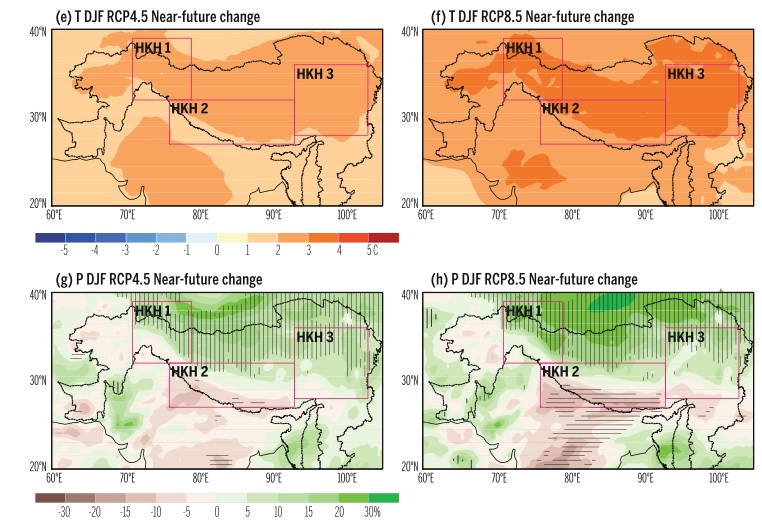
A NEW TRAGEDY OF THE COMMONS?
The deep irony is that China persists in taking its great rivers rising in Tibet as common pool resources for exploitation; while accusing Tibetan pastoralists of abusing the common pool resource of Tibetan pasture lands for unsustainable exploitation.
What China above all wants from Tibet is water, and is willing to depopulate Tibet to maximise water flow. Yet in reality the alpine meadows of Tibet are inseparable from the rivers flowing for a thousand kms or more through them, from their glacial sources across the pastoral landscapes before tilting to the lowlands.
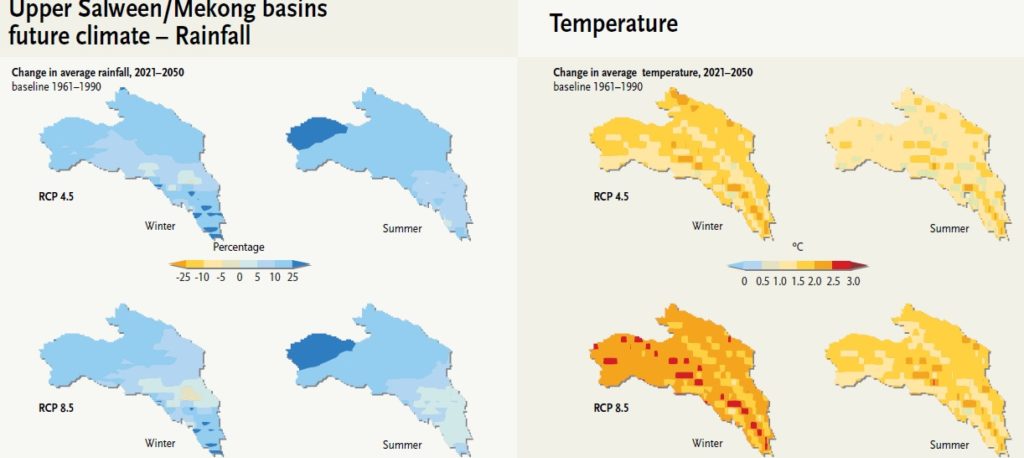
China, however, treats the rivers as sacred, and their pastoral meanderings among Tibetan livestock producers as a threat to the reliable provisioning of lowland China with upland water, glacially pure. When assessing grassland, China assumes common pool resources will inevitably be abused, because what belongs to everyone thus belongs to no-one. Yet when it comes to the waters of Tibet China treats this common pool resource as vitally valuable to lowland China, to be protected upstream by cancelling human land use.
China in early 2019 announced a massive expansion of hydro dams and power grids on the rivers of Tibet, especially on the Yangtze (Dri Chu in Tibetan) and its many Tibetan tributaries, as damming of the Yellow River in Tibet was completed decades ago. As the world’s most hydraulic economy, China has impounded, diverted and extracted more water from rivers than anywhere on our planet. In t[1]he name of renewable energy and carbon emissions mitigation, China is intensifying these programs. China’s anxiety over water means it also publishes more on water problems than any other country.
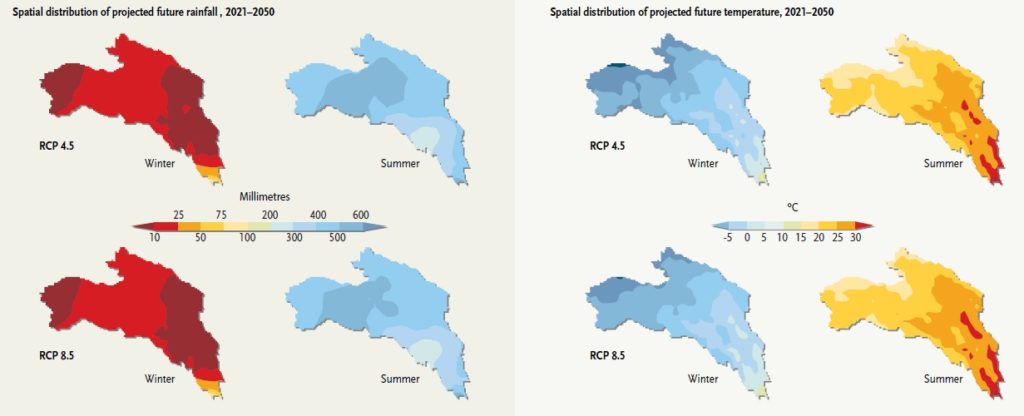
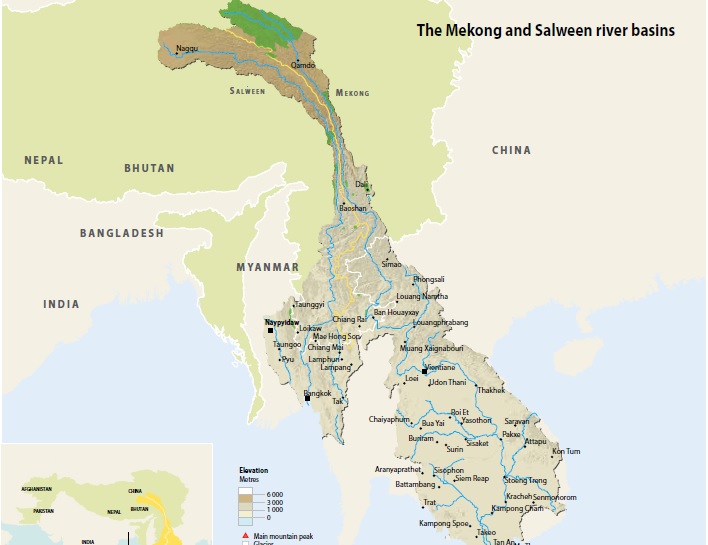
Yet China’s argument for depopulating vast rangelands of Tibet, especially in the river source area, which is bigger than Germany, is that the nomads irresponsibly degraded the land by overgrazing, paying no heed to the health of the commons.
Factually, this is baseless. Many Chinese scientists have shown in fieldwork studies of the skilful use of pasture by Tibetan nomads, who always move on well before grasses are overgrazed, mindful of the need to protect their long term livelihoods.[2] It is China’s restrictions on nomadic mobility that caused the overgrazing which China blames on careless nomads abusing the commons.
China has invested much effort in quantifying the runoff dividend, also in hydro damming the Yellow River in many places in Tibet (Qinghai in Chinese), plus excessive extraction of Yellow River waters in arid regions with abundant coal, to supply all of China with electricity and much else, even milk from Inner Mongolia from intensive factory farms made possible only by abundant water coming down the Yellow River, traversing the desert.
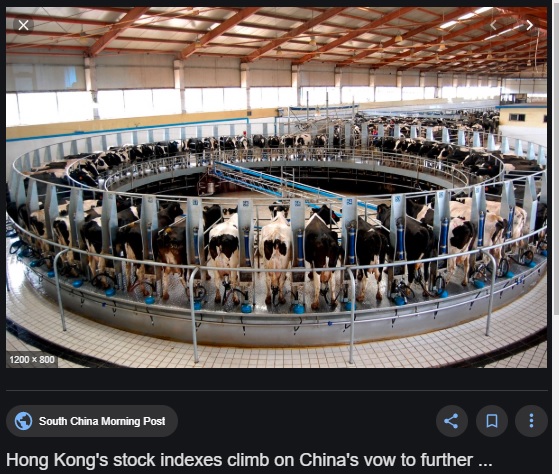
Water as a free public good has been foundational for all these lowland industries, so much so that China officially labels Tibet as China’s Number One Water Tower, gravity feeding endless water to the lowlands. Water shows up very little as a cost in the accounts of industrial enterprises, only as a last mile expense of installing pumps and pipes for extraction. Since the actual value of water to industry, intensive agribusiness and cities has never been internalised as an actual cost, the glacier melt runoff dividend is likewise off the account books, a silent dividend.
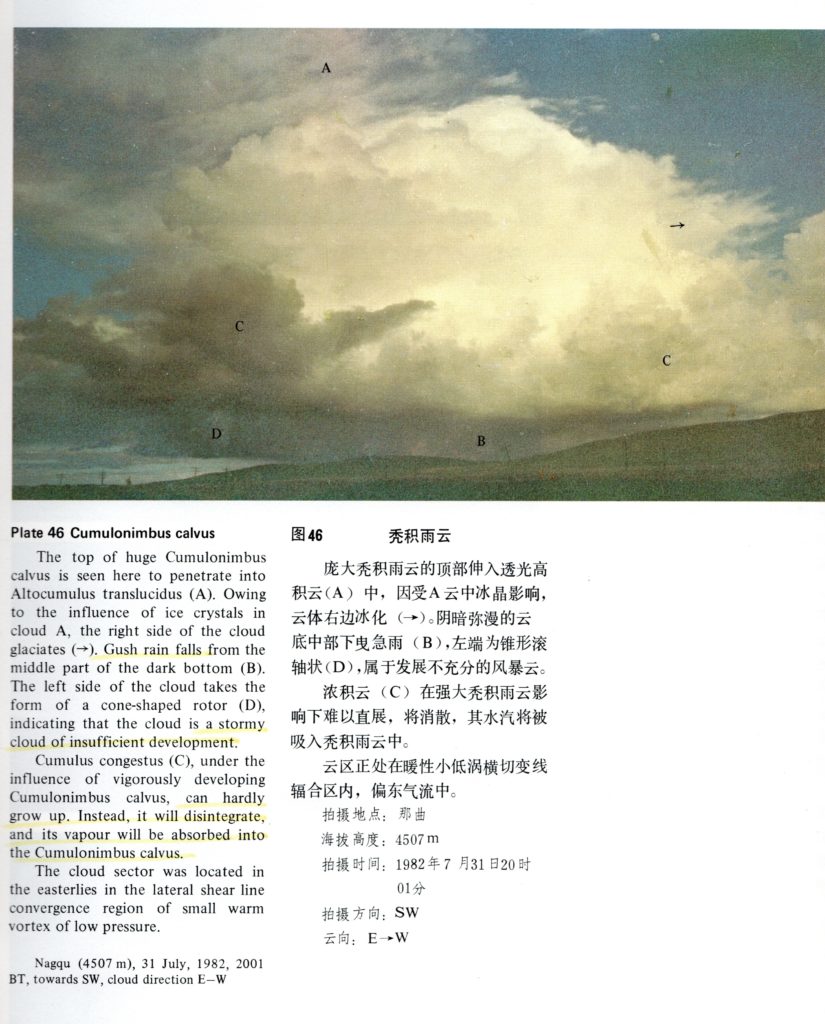
Source: Atlas of Clouds over the Qinghai-Xizang Plateau,1986
That dividend shows up not in the corporate bottom line but politically, in China’s program to depopulate the Tibetan highlands, to clear out the pasture users between the glaciers and the lowlands. Guaranteeing water supply is officially the main driver of the policy of closing pastures to grow more grass and protect water supply, a policy over the past two decades that has made redundant hundreds of thousands of skilled Tibetan pastoralists in the river catchments below the glaciers but above the Chinese industrial consumers.
On the Yellow River, the dividend will peak seasonally when it is most needed downriver, in winter, the season when the Yellow River in some recent years has dried up altogether hundreds of kms before reaching the sea. Winter temperatures are rising fast in Tibet.
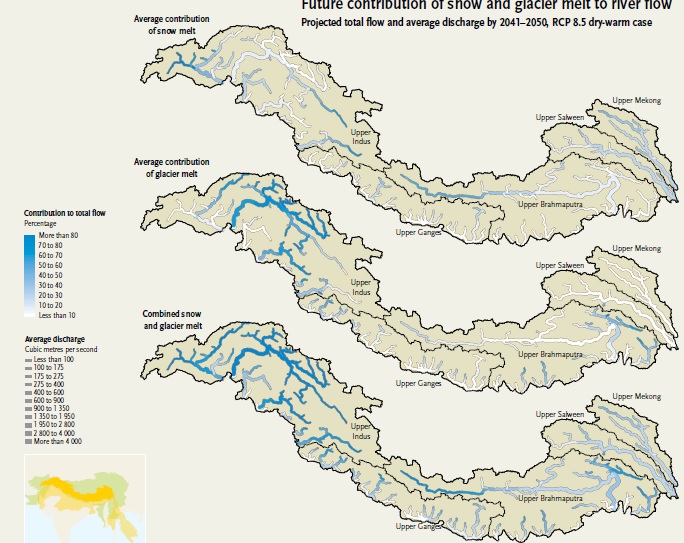
Source: ICIMOD Atlas of Himalayan Climate, 2015
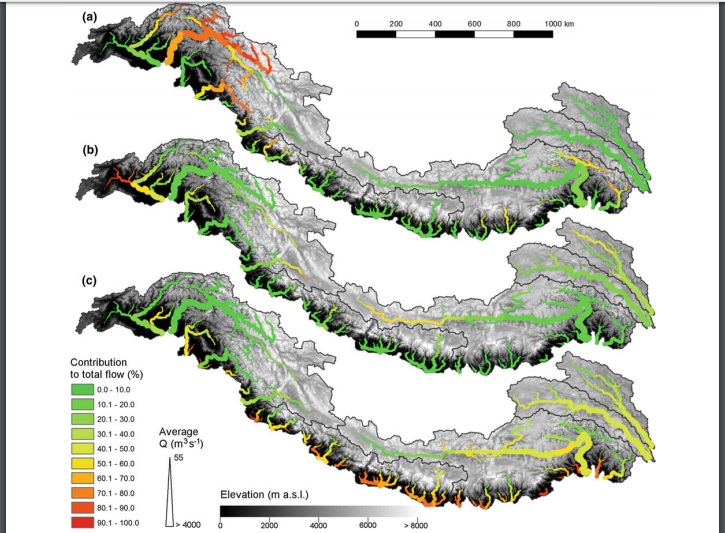
Consistent increase in High Asia’s runoff due to increasing glacier melt and precipitation. 1998 to 2007 Contribution to total flow by glacier melt (a), snow melt (b) and rainfall runoff (c) for major streams during the reference period (1998–2007)
Nature Climate Change, 4, 587-592, 2014
While agriculture has little need of water in winter, factories and cities need reliable water provisioning year-round. Climate change in Tibet is especially strong in winter, IPCC reports, with rapidly rising temperatures releasing glacier melt even in winter. Further, the IPCC reports evidence that in Tibet as climate change accelerates, summer flow will decrease by as much as 10 per cent. (Section 2.3.1.1 Changes in River Runoff) The summer monsoon, especially along the Yangtze, is flood danger time, so a summer flow reduction and a winter boost would be ideal. China needs its dividend, which makes it reluctant to act decisively to reduce emissions, curb climate warming and save the planet.
No-one can say how big the glacier melt dividend will be in coming decades. Attempting to quantify it would require far more river flow gauging stations, meteorological stations and remote sensing satellite data. Even the IPCC, ICIMOD and the scientists whose work they review and summarise, cannot say with certainty how big a dividend China will obtain by gravity flow from Tibetan glaciers and rivers.
But that dividend is just the added benefit of what China routinely harvests from Tibet, the daily flow of river runoff from the plateau, from a common pool resource taken for granted, until it is deemed under threat –by the very people in Tibet who have protected streams and rivers for thousands of years.[3]
#gabriellafitte
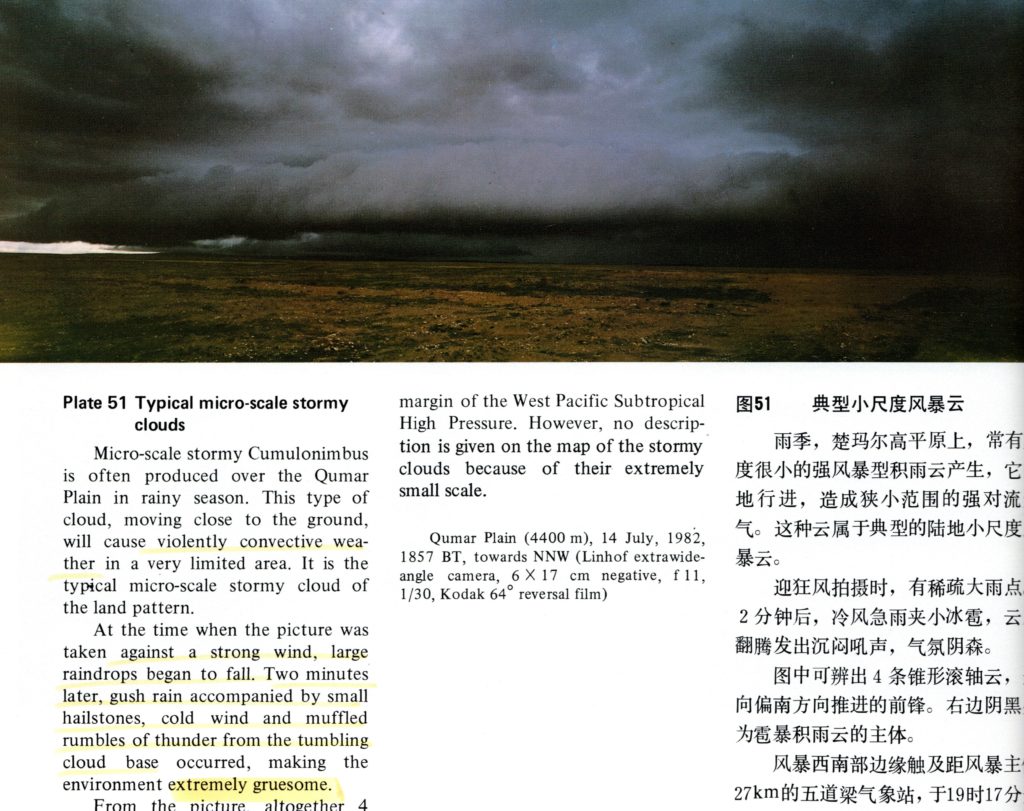
Source: Atlas of Clouds over the Qinghai-Xizang Plateau, 1986
[1] Wen Li (State Key Laboratory of Eco-hydraulics in Northwest Arid Region of China), Water Ecological Environment Protection under Changing Environment: A Systematic Review and Bibliometric Analysis, Journal of Coastal Research, Special Issue No. 93, 2019
[2] Y B Li, Gongbuzeren (Gonpo Tsering), W J Li (2014) A Review of China’s Rangeland Management Policies. IIED country report. IIED, London. http://pubs.iied.org/10079IIED
LI Bo et al., Review of CCA Studies in SW China,
https://www.iccaconsortium.org › 2015/08 › regional-review-south-west-china-en
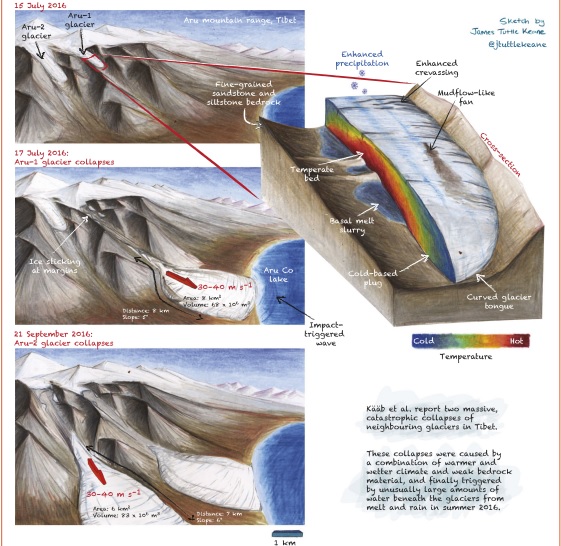
[3] Xiaoli Shen , Zhi Lu, Shengzhi Li, and Nyima Chen, Tibetan Sacred Sites: Understanding the Traditional Management System and Its Role in Modern Conservation, Ecology and Society 17(2): 13.
Freely downloadable from: http://dx.doi.org/10.5751/ES-04785-170213
XÉNIA DE HEERING and Élisabeth Guill, Providing Access to Water: The pump, the spring and the klu: Brokerage and local development on the Tibetan Plateau, China Perspectives, No. 1 (93) (2013), pp. 61-71
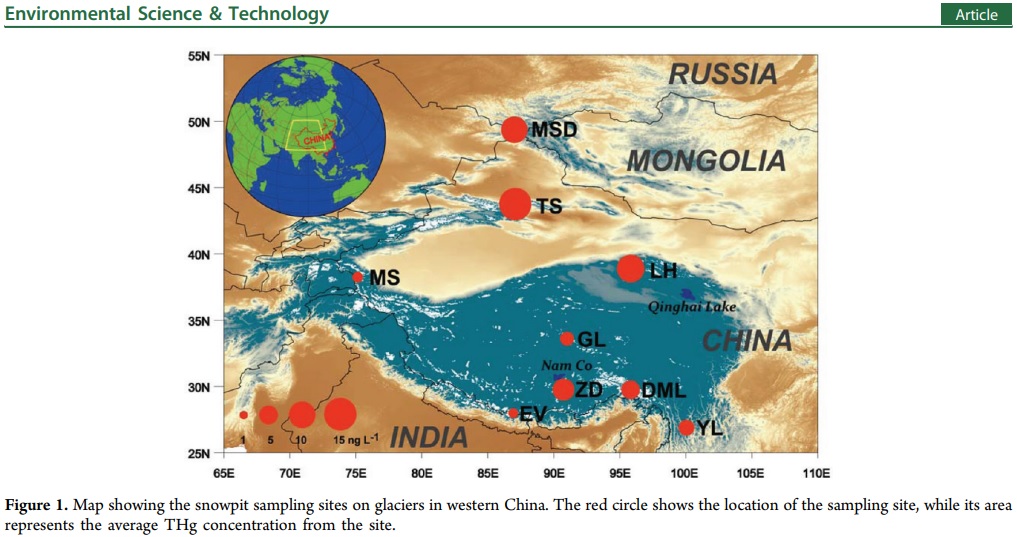
Source: IPCC 2019 and Zhang 2014